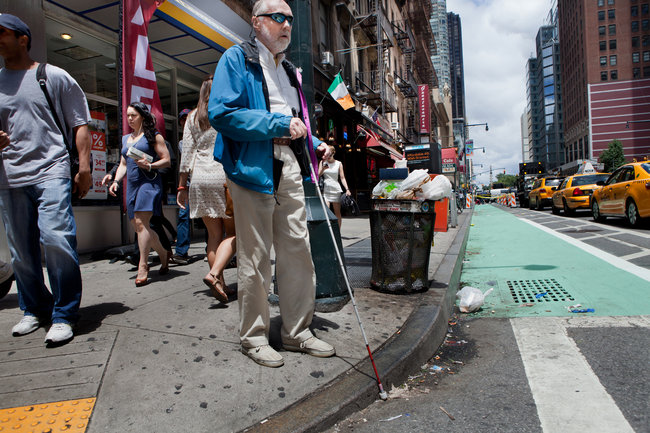As with any thriving metropolis, the New York streetscape is constantly changing. Whether related to sidewalk and street repair, utility maintenance or building construction, obstacles emerge and disappear around the clock, often leaving changes in their wake, in every corner of the city.

For the physically impaired, of course, any of these changes can present a challenge. Yet for some reason the New York Times, in a story published Sunday, chose to single out two types of street alterations with a record of improving safety -- pedestrian plazas and bike lanes -- as posing a danger to blind and visually impaired New Yorkers. Here's a taste:
Ms. [Maria] Hansen, who travels with a German shepherd, Frisco, as a guide, said she had begun avoiding areas like Times Square, which she used to frequent, because pedestrian plazas have been added.
“There is no definition of where the street is,” she said on a recent afternoon, as Frisco eyed a parade of less altruistic dogs from beneath a bench in Madison Square Park.
Another concern is the city’s historic embrace of a bike-share program, which is scheduled to begin this summer and will introduce 10,000 new bicycles to the streets by next summer. Though many visually impaired residents have lauded the city’s green ambitions, some are worried that an increase in vehicles that move inaudibly, and unpredictably, could be dangerous.
If this story is intended to take the city to task for not doing more to ensure safe mobility for the blind and visually impaired, reporter Matt Flegenheimer left out a few salient facts.
For example: Pedestrian plazas and bike lanes have saved lives and prevented injuries across the board. After the city installed a bike lane and new pedestrian spaces on Broadway through the heart of Midtown, pedestrian injuries in the area dropped by 35 percent. It may be that these facilities could work better for the blind than they do now, but there is no data to indicate that they have made conditions less safe for anyone.
Few would argue against DOT doing everything in its power to accommodate those who can't negotiate city streets the way most New Yorkers do. But without acknowledging safety gains brought about by new pedestrian and cyclist infrastructure, it's hard to take Flegenheimer's story as anything other than another Times attack on safer streets.





